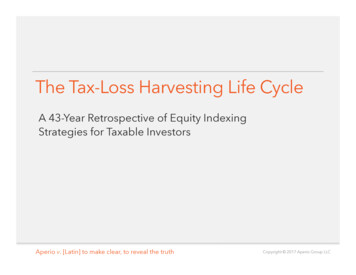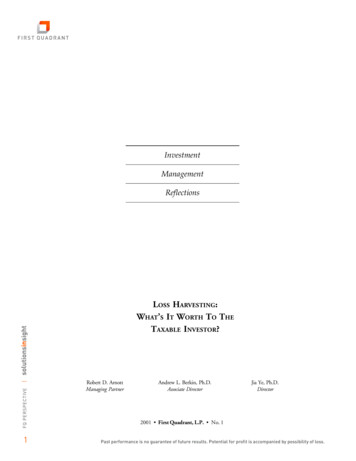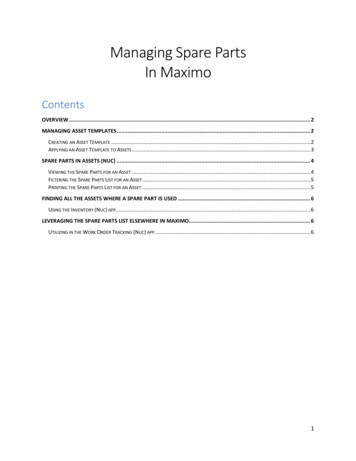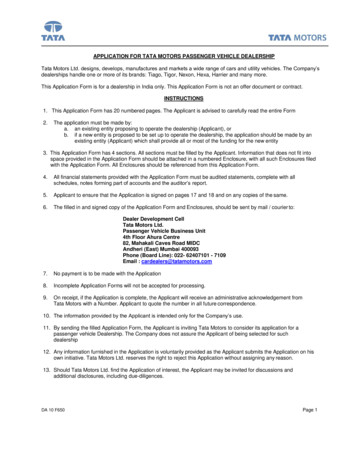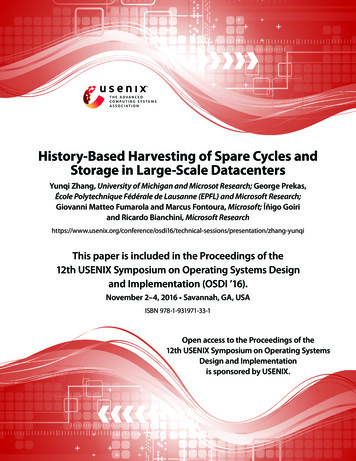
Transcription
History-Based Harvesting of Spare Cycles andStorage in Large-Scale DatacentersYunqi Zhang, University of Michigan and Microsot Research; George Prekas,École Polytechnique Fédérale de Lausanne (EPFL) and Microsoft Research;Giovanni Matteo Fumarola and Marcus Fontoura, Microsoft; Íñigo Goiriand Ricardo Bianchini, Microsoft echnical-sessions/presentation/zhang-yunqiThis paper is included in the Proceedings of the12th USENIX Symposium on Operating Systems Designand Implementation (OSDI ’16).November 2–4, 2016 Savannah, GA, USAISBN 978-1-931971-33-1Open access to the Proceedings of the12th USENIX Symposium on Operating SystemsDesign and Implementationis sponsored by USENIX.
History-Based Harvesting of Spare Cycles and Storage inLarge-Scale DatacentersYunqi Zhang† George Prekas‡ Giovanni Matteo Fumaroladd?Marcus FontouraÍñigo GoiriRicardo Bianchini?† Universityof Michigan‡ EPFLAbstractAn effective way to increase utilization and reduce costsin datacenters is to co-locate their latency-critical services and batch workloads. In this paper, we describesystems that harvest spare compute cycles and storagespace for co-location purposes. The main challengeis minimizing the performance impact on the services,while accounting for their utilization and managementpatterns. To overcome this challenge, we propose techniques for giving the services priority over the resources,and leveraging historical information about them. Basedon this information, we schedule related batch tasks onservers that exhibit similar patterns and will likely haveenough available resources for the tasks’ durations, andplace data replicas at servers that exhibit diverse patterns.We characterize the dynamics of how services are utilized and managed in ten large-scale production datacenters. Using real experiments and simulations, we showthat our techniques eliminate data loss and unavailabilityin many scenarios, while protecting the co-located services and improving batch job execution time.1IntroductionMotivation. Purchasing servers dominates the total costof ownership (TCO) of large-scale datacenters [4], suchas those operated by Google and Microsoft. Unfortunately, the servers’ average utilization is often low, especially in clusters that host user-facing, interactive services [4, 10]. The reasons for this include: these servicesare often latency-critical (i.e., require low tail responsetimes); may exhibit high peaks in user load; and mustreserve capacity for unexpected load spikes and failures.An effective approach for extracting more value fromthe servers is the co-location of useful batch workloads(e.g., data analytics, machine learning) and the data theyrequire on the same servers that perform other functions, Thiswork was done while Zhang and Prekas were interns at MSR.USENIX Associationd Microsoft? MicrosoftResearchincluding those that run latency-critical services. However, for co-location with these services to be acceptable,we must shield them from any non-trivial performanceinterference produced by the batch workloads or theirstorage accesses, even when unexpected events occur. Ifco-location starts to degrade response times, the scheduler must throttle or even kill (and re-start elsewhere) theculprit batch workloads. In either case, the performanceof the batch workloads suffers. Nevertheless, co-locationultimately reduces TCO [37], as the batch workloads arenot latency-critical and share the same infrastructure asthe services, instead of needing their own.Recent scheduling research has considered how tocarefully select which batch workload to co-locate witheach service to minimize the potential for interference(most commonly, last-level cache interference), e.g. [9,10, 25, 42]. However, these works either assume simple sequential batch applications or overlook the resourceutilization dynamics of real services. Scheduling dataintensive workloads comprising many distributed tasks(e.g., data analytics jobs) is challenging, as schedulingdecisions must be made in tandem for collections ofthese tasks for best performance. The resource utilization dynamics make matters worse. For example, a longrunning workload may have some of its tasks throttled orkilled when the load on a co-located service increases.Moreover, no prior study has explored in detail theco-location of services with data for batch workloads.Real services often leave large amounts of spare storagespace (and bandwidth) that can be used to store the dataneeded by the batch workloads. However, co-locatingstorage raises even more challenges, as the managementand utilization of the services may affect data durability and availability. For example, service engineers andthe management system itself may reimage (reformat)disks, deleting all of their data. Reimaging typically results from persistent state management, service deployment, robustness testing, or disk failure. Co-location andreimaging may cause all replicas of a data block to be12th USENIX Symposium on Operating Systems Design and Implementation755
destroyed before they can be re-generated.Our work. In this paper, we propose techniques for harvesting the spare compute cycles and storage space indatacenters for distributed batch workloads. We refer tothe original workloads of each server as its “primary tenant”, and to any resource-harvesting workload (i.e., batchcompute tasks or their storage accesses) on the server asa “secondary tenant”. We give priority over each server’sresources to its primary tenant; secondary tenants maybe killed (in case of tasks) or denied (in case of storageaccesses) when the primary tenant needs the resources.To reduce the number of task killings and improve dataavailability and durability, we propose task schedulingand data placement techniques that rely on historical resource utilization and disk reimaging patterns. We logically group primary tenants that exhibit similar patternsin these dimensions. Using the utilization groups, ourscheduling technique schedules related batch tasks onservers that have similar patterns and enough resourcesfor the tasks’ expected durations, and thereby avoids creating stragglers due to a lack of resources. Using the utilization and reimaging groups, our data placement technique places data replicas in servers with diverse patterns, and thereby increases durability and availabilitydespite the harvested nature of the storage resources.To create the groups, we characterize the primary tenants’ utilization and reimaging patterns in ten productiondatacenters,1 including a popular search engine and itssupporting services. Each datacenter hosts up to tens ofthousands of servers. Our characterization shows that thecommon wisdom that datacenter workloads are periodicis inaccurate, since often most servers do not execute interactive services. We target all servers for harvesting.Implementation and results. We implement our techniques into the YARN scheduler, Tez job manager, andHDFS file system [11, 29, 36] from the Apache Hadoopstack. (Primary tenants use their own scheduling and filesystems.) Stock YARN and HDFS assume there are noexternal workloads, so we also make these systems awareof primary tenants and their resource usage.We evaluate our systems using 102 servers in a production datacenter, with utilization and reimaging behaviors scaled down from it. We also use simulations tostudy our systems for longer periods and for larger clusters. The results show that our systems (1) can improvethe average batch job execution time by up to 90%; and(2) can reduce data loss by more than two orders of magnitude when blocks are replicated three times, eliminatedata loss under four-way replication, and eliminate dataunavailability for most utilization levels.Finally, we recently deployed our file system in large1 For confidentiality, we omit certain information, such as absolutenumbers of servers and actual utilizations, focusing instead on coarsebehavior patterns and full-range utilization exploration.756scale production (our scheduler is next), so we discussour experience and lessons that may be useful to others.Summary and conclusions. Our contributions are: We characterize the dynamics of how servers are usedand managed in ten production datacenters. We propose techniques for improving task schedulingand data placement based on the historical behavior ofprimary tenants and how they are managed. We extend the Hadoop stack to harvest the spare cycles and storage in datacenters using our techniques. We evaluate our systems using real experiments andsimulations, and show large improvements in batchjob performance, data durability, and data availability. We discuss our experience with large-scale productiondeployments of our techniques.We conclude that resource harvesting benefits significantly from a detailed accounting of the resource usageand management patterns of the primary workloads. Thisaccounting enables higher utilization and lower TCO.2Related WorkDatacenter characterization. Prior works from datacenter operators have studied selected production clusters, not entire datacenters, e.g. [37]. Instead, we characterize all primary tenants in ten datacenters, including those used for production latency-critical and noncritical services, for service development and testing, andthose awaiting use or being prepared for decommission.Harvesting of resources without co-location. Priorworks have proposed to harvest resources for batchworkloads in the absence of co-located latency-criticalservices, e.g. [22, 23]. Our work focuses on the morechallenging co-location scenario in modern datacenters.Co-location of latency-critical and batch tasks. Recent research has targeted two aspects of co-location: (1)performance isolation – ensuring that batch tasks do notinterfere with services, after they have been co-locatedon the same server [19, 20, 21, 24, 27, 31, 32, 38, 42]; or(2) scheduling – selecting which tasks to co-locate witheach service to minimize interference or improve packing quality [9, 10, 12, 25, 37, 43]. Borg addresses bothaspects in Google’s datacenters, using Linux cgroupbased containers, special treatment for latency-criticaltasks, and resource harvesting from containers [37].Our work differs substantially from these efforts. Asisolation and interference-aware scheduling have beenwell-studied, we leave the implementation of these techniques for future work. Instead, we reserve compute resources that cannot be given to batch tasks; a spiking primary tenant can immediately consume this reserve untilour software can react (within a few seconds at most) toreplenish the reserve. Combining our systems with finergrained isolation techniques will enable smaller reserves.12th USENIX Symposium on Operating Systems Design and ImplementationUSENIX Association
Moreover, unlike services at Google, our primary tenants “own” their servers, and do not declare their potential resource needs. This means that we must harvestresources carefully to prevent interference with latencycritical services and degraded batch job performance.Thus, we go beyond prior works by understanding andexploiting the primary tenants’ resource usage dynamics to reduce the need for killing batch tasks. With respect to resource usage dynamics, a related paper is [5],which derives Service-Level Objectives (SLOs) for resource availability from historical utilization data. Weleverage similar data but for dynamic task scheduling,which their paper did not address.Also importantly, we are the first to explore in detailthe harvesting of storage space from primary tenants fordata-intensive batch jobs. This scenario involves understanding how primary tenants are managed, as well astheir resource usage.For both compute and storage harvesting, we leverage primary and secondary tenants’ historical behaviors, which are often more accurate than user annotations/estimates (e.g., [35]). Any system that harvests resources from latency-critical workloads can benefit fromleveraging the same behaviors.Data-processing frameworks and co-location. Researchers have proposed improvements to the Hadoopstack in the absence of co-location, e.g. [3, 8, 13, 14,15, 18, 39]. Others considered Hadoop (version 1) in colocation scenarios using virtual machines, but ran HDFSon dedicated servers [7, 30, 41]. Lin et al. [22] storeddata on dedicated and volunteered computers (idle desktops), but in the absence of primary tenants. We are notaware of studies of Mesos [16] in co-location scenarios.Bistro [12] relies on static resource reservations for services, and schedules batch jobs on the leftover resources.In contrast to these works, we propose dynamic scheduling and data placement techniques for the Hadoop stack,and explore the performance, data availability, and datadurability of co-located primary and secondary tenants.3Characterizing Behavior PatternsWe now characterize the primary tenants in ten production datacenters. In later sections, we use the characterization for our co-location techniques and results.3.1Data sources and terminologyWe leverage data collected by AutoPilot [17], the primary tenant management and deployment system usedin the datacenters. Under AutoPilot, each server is partof an environment (a collection of servers that are logically related, e.g. indexing servers of a search engine)USENIX Associationand executes a machine function (a specific functionality, e.g. result ranking). Environments can be used forproduction, development, or testing. In our terminology,each primary tenant is equivalent to an environment,machine function pair. Primary tenants run on physicalhardware, without virtualization. Each datacenter has between a few hundred to a few thousand primary tenants.Though our study focuses on AutoPilot-managed datacenters, our characterization and techniques should beeasily applicable to other management systems as well.In fact, similar telemetry is commonly collected in otherproduction datacenters, e.g. GWP [28] at Google andScuba [2] at Facebook.3.2Resource utilizationAutoPilot records the primary tenant utilization perserver for all hardware resources, but for simplicity wefocus on the CPU in this paper. It records the CPU utilization every two minutes. As the load is not alwaysevenly balanced across all servers of a primary tenant,we compute the average of their utilizations in each timeslot, and use the utilization of this “average” server forone month to represent the primary tenant.We then identify trends in the tenants’ utilizations,using signal processing. Specifically, we use the FastFourier Transform (FFT) on the data from each primarytenant individually. The FFT transforms the utilizationtime series into the frequency domain, making it easy toidentify any periodicity (and its strength) in the series.We identify three main classes of primary tenants: periodic, unpredictable, and (roughly) constant. Figure 1shows the CPU utilization trends of a periodic and anunpredictable primary tenant in the time and frequencydomains. Figure 1b shows a strong signal at frequency31, because there are 31 days (load peaks and valleys)in that month. In contrast, Figure 1d shows a decreasing trend in signal strength as the frequency increases, asthe majority of the signal derives from events that rarelyhappen (i.e., exhibit lower frequency).As one would expect, user-facing primary tenants often exhibit periodic utilization (e.g., high during the dayand low at night), whereas non-user-facing (e.g., Webcrawling, batch data analytics) or non-production (e.g.,development, testing) primary tenants often do not. Forexample, a Web crawling or data scrubber tenant mayexhibit (roughly) constant utilization, whereas a testingtenant often exhibits unpredictable utilization behavior.More interestingly, Figure 2 shows that user-facing(periodic) primary tenants are actually a small minority.The vast majority of primary tenants exhibit roughly constant CPU utilization. Nevertheless, Figure 3 shows thatthe periodic primary tenants represent a large percentage ( 40% on average) of the servers in each datacenter.12th USENIX Symposium on Operating Systems Design and Implementation757
(a) Periodic – time(b) Periodic – frequency(c) Unpredictable – time(d) Unpredictable – frequencyFigure 1: Sample periodic and unpredictable one-month traces in the time and frequency domains.Figure 2: Percentages of primary tenants per class.Figure 3: Percentages of servers per class.Still, the non-periodic primary tenants account for morethan half of the tenants and servers.Most importantly, the vast majority of servers ( 75%)run primary tenants (periodic and constant) for whichthe historical utilization data is a good predictor of future behaviors (the utilizations repeat periodically or allthe time). Thus, leveraging this data should improve thequality of both our task scheduling and data placement.per server. This data includes reimages of multiple types:(1) those initiated manually by developers or service operators intending to re-deploy their environments (primary tenants) or re-start them from scratch; (2) thoseinitiated by AutoPilot to test the resilience of productionservices; and (3) those initiated by AutoPilot when diskshave undergone maintenance (e.g., tested for failure).We now study the reimaging patterns using three yearsof data from AutoPilot. As an example of the reimagingfrequencies we observe, Figure 4 shows the CumulativeDistribution Function (CDF) of the average number ofreimages per month for each server in three years in fiverepresentative datacenters in our sample. Figure 5 showsthe CDF of the average number of reimages per serverper month for each primary tenant for the same years anddatacenters. The discontinuities in this figure are due toshort-lived primary tenants.We make three observations from these figures. Firstand most importantly, there is a good amount of diver-3.3Disk reimagingDisk reimages are relatively frequent for some primarytenants, which by itself potentially threatens data durability under co-location. Even worse, disk reimages areoften correlated, i.e. many servers might be reimaged atthe same time (e.g., when servers are repurposed fromone primary tenant to another). Thus, it is critical fordata durability to account for reimages and correlations.AutoPilot collects disk reimaging (reformatting) data75812th USENIX Symposium on Operating Systems Design and ImplementationUSENIX Association
100Percentage of primary tenantsPercentage of es / month1.580602002Figure 4: Per-server number of reimages in three years.DC-0DC-1DC-3DC-7DC-9400510Group changes from month to month1520Figure 6: Number of times a primary tenant changedreimage frequency groups in three years.Percentage of primary es / server / month1.52Figure 5: Per-tenant number of reimages in three years.sity in average reimaging frequency across primary tenants in each datacenter (Figure 5 does not show nearlyvertical lines). Second, the reimaging frequencies permonth are fairly low in all datacenters. For example, atleast 90% of servers are reimaged once or fewer timesper month on average, whereas at least 80% of primarytenants are reimaged once or fewer times per server permonth on average. This shows that reimaging by primarytenant engineers and AutoPilot is not overly aggressiveon average, but there is a significant tail of servers (10%)and primary tenants (20%) that are reimaged relativelyfrequently. Third, the primary tenant reimaging behaviors are fairly consistent across datacenters, though threedatacenters show substantially lower reimaging rates perserver (we show two of those datacenters in Figure 4).The remaining question is whether each primary tenant exhibits roughly the same frequencies month aftermonth. In this respect, we find that there is substantialvariation, as frequencies sometimes change substantially.Nevertheless, when compared to each other, primarytenants tend to rank consistently in the same part of thespectrum. In other words, primary tenants that experience a relatively small (large) number of reimages in amonth tend to experience a relatively small (large) number of reimages in the following month. To verify thistrend, we split the primary tenants of a datacenter intothree frequency groups, each with the same number oftenants: infrequent, intermediate, and frequent. Then,we track the movement of the primary tenants acrossthese groups over time. Figure 6 plots the CDF of thenumber of times a primary tenant changed groups fromone month to the next. At least 80% of primary tenantsUSENIX Associationchanged groups only 8 or fewer times out of the possible35 changes in three years. This behavior is also consistent across datacenters.Again, these figures show that historical reimagingdata should provide meaningful information about thefuture. Using this data should improve data placement.4Smart Co-location TechniquesIn this section, we describe our techniques for smart taskscheduling and data placement, which leverage the primary tenants’ historical behavior patterns.4.1Smart task schedulingWe seek to schedule batch tasks (secondary tenants) toharvest spare cycles from servers that natively run interactive services and their supporting workloads (primary tenants). Modern cluster schedulers achieve highjob performance and/or fairness, so they are good candidates for this use. However, their designs typically assume dedicated servers, i.e. there are no primary tenantsrunning on the same servers. Thus, we must (1) modify them to become aware of the primary tenants andthe primary tenants’ priority over the servers’ resources;and (2) endow them with scheduling algorithms that reduce the number of task killings resulting from the colocated primary tenants’ need for resources. The first requirement is fairly easy to accomplish, so we describeour implementation in Section 5. Here, we focus on thesecond requirement, i.e. smart task scheduling, and usehistorical primary tenant utilization data to select serversthat will most likely have the required resources availablethroughout the tasks’ entire executions.Due to the sheer number of primary tenants, it wouldbe impractical to treat them independently during taskscheduling. Thus, our scheduling technique first clusters together primary tenants that have similar utilizationpatterns into the same utilization class, and then select aclass for the tasks of a job. Next, we discuss our clustering and class selection algorithms in turn.12th USENIX Symposium on Operating Systems Design and Implementation759
Number of Concurrent TasksAlgorithm 1 Class selection algorithm.1: Given: Classes C, Headroom(type,c), Ranking Weights W2: function S CHEDULE(Batch job J)3:J.type Length (short, medium, or long) from its last run4:J.req Max amount of concurrent resources from DAG5:for each c 2 C do6:c.weightedroom Headroom(J.type,c) W [J.type,c.class]7:end for8:F {8c 2 C Headroom(J.type,c) J.req}9:if F 6 0/ then10:Pick 1 class c 2 F probabilistically µ c.weightedroom11:return {c}12:else if Job J can fit in multiple classes combined then13:Pick {c0 , . . . , ck } C probabilistically µ c.weightedroom14:return {c0 , . . . , ck }15:else16:Do not pick classes17:return {0}/18:end if19: end functionThe clustering algorithm periodically (e.g., once perday) takes the most recent time series of CPU utilizations from the average server of each primary tenant, runsthe FFT algorithm on the series, groups the tenants intothe three patterns described in Section 3 (periodic, constant, unpredictable) based on their frequency profiles,and then uses the K-Means algorithm to cluster the profiles in each pattern into classes. Clustering tags eachclass with the utilization pattern, its average utilization,and its peak utilization. It also maintains a mapping between the classes and their primary tenants.As we detail in Algorithm 1, our class selection algorithm relies on the classes defined by the clusteringalgorithm. When we need to allocate resources for ajob’s tasks, the algorithm selects a class (or classes) according to the expected job length (line 3) and a predetermined ranking of classes for the length. We represent the desired ranking using weights (line 6); higherweight means higher ranking. For a long job, we give priority to constant classes first, then periodic classes, andfinally unpredictable classes. We prioritize the constantclasses in this case because constant-utilization primarytenants with enough available resources are unlikely totake resources away from the job during its execution. Atthe other extreme, a short job does not require an assurance of resource availability long into the future; knowing the current utilization is enough. Thus, for a shortjob, we rank the classes unpredictable first, then periodic, and finally constant. For a medium job, the rankingis periodic first, then constant, and finally unpredictable.We categorize a job as short, medium, or long bycomparing the duration of its last execution to two predefined thresholds (line 3). We set the thresholds basedon the historical distribution of job lengths and the current computational capacity of each preferred tenantclass (e.g., the total computation required by long jobs760(8)(469)Mapper 1Mapper 2(1)(469)(113)(138)(6)(1)Mapper 10Reducer 5Reducer 6Reducer 7(2)(138)(6)(1)Mapper 8Reducer 3(1)(113)(126)Mapper 9Reducer 4(3)(126)Mapper 11(1)Figure 7: Example job execution DAG.should be proportional to the computational capacity ofconstant primary tenants). Importantly, the last durationneed not be an accurate execution time estimate. Ourgoal is much easier: to categorize jobs into three roughtypes. We assume that a job that has not executed beforeis a medium job. After a possible error in this first guess,we find that a job consistently falls into the same type.We estimate the maximum amount of concurrent resources that the job will need (line 4) using a breadthfirst traversal of the job’s directed acyclic graph (DAG),which is a common representation of execution flows inmany frameworks [1, 29, 40]. We find this estimate to beaccurate for our workloads. Figure 7 shows an examplejob DAG (query 19 from TPC-DS [34]), for which weestimate a maximum of 469 concurrent containers.Whether a job “fits” in a class (line 8) depends on theamount of available resources (or the amount of headroom) that the servers in the class currently exhibit, aswe define below. When multiple classes could host thejob, the algorithm selects one with probability proportional to its weighted headroom (lines 9 and 10). If multiple classes are necessary, it selects as many classes asneeded, again probabilistically (lines 12 and 13). If thereare not enough resources available in any combination ofclasses, it does not select any class (line 16).The headroom depends on the job type. For a shortjob, we define it as 1 minus the current average CPU utilization of the servers in the class. For a medium job, weuse 1 minus Max(average CPU utilization, current CPUutilization). For a long job, we use 1 minus Max(peakCPU utilization, current CPU utilization).4.2Smart data placementModern distributed file systems achieve high data access performance, availability, and durability, so thereis a strong incentive for using them in our harvestingscenario. However, like cluster schedulers, they assumededicated servers without primary tenants running andstoring data on the same servers, and without primarytenant owners deliberately reimaging disks. Thus, we12th USENIX Symposium on Operating Systems Design and ImplementationUSENIX Association
Algorithm 2 Replica placement algorithm.1: Given: Storage space available in each server, Primary reimaging2:stats, Primary peak CPU util stats, Desired replication R3: function P LACE REPLICAS(Block B)4:Cluster primary tenants wrt reimaging and peak CPU util5:into 9 classes, each with the same total space6:Select the class of the server creating the block7:Select the server creating the block for one replica8:for r 2; r R; r r 1 do9:Select the next class randomly under two constraints:10:No class in the same row has been picked11:No class in the same column has been picked12:Pick a random primary tenant of this class as long as13:its environment has not received a replica14:Pick a server in this primary tenant for the next replica15:if (r mod 3) 0 then16:Forget rows and columns that have been selected so far17:end if18:end for19: end functionmust (1) modify them to become co-location-aware; and(2) endow them with replica placement algorithms thatimprove data availability and durability in the face of primary tenants and how they are managed. Again, the firstrequirement is fairly easy to accomplish, so we discussour implementation in Section 5. Here, we focus on thesecond requirement, i.e. smart replica placement.The challenge is that the primary tenants and the management system may hurt data availability and durabilityfor any block: (1) if the replicas of a block are storedin primary tenants that load-spike at the same time, theblock may become unavailable; (2) if developers or themanagement system reimage the disks containing all thereplicas of a block in a short time span, the block will belost. A replica placement algorithm must then accountfor primary tenant and management system activity.An intuitive best-first approach would be to try to findprimary tenants that reimage their disks the least, andfrom these primary tenants select the ones that have lowest CPU utilizations. However, this greedy approach hastwo serious flaws. First, it treats durability and availability independently, one after the other, ignoring theirinteractions. Second, after the space at all the “good”primary tenants is exhausted, new replicas would haveto be created at locations that would likely le
lization and reimaging groups, our data placement tech-nique places data replicas in servers with diverse pat-terns, and thereby increases durability and availability despite the harvested nature of the storage resources. To create the groups, we characterize the primary ten-ants' utilization and reimaging patterns in ten production
